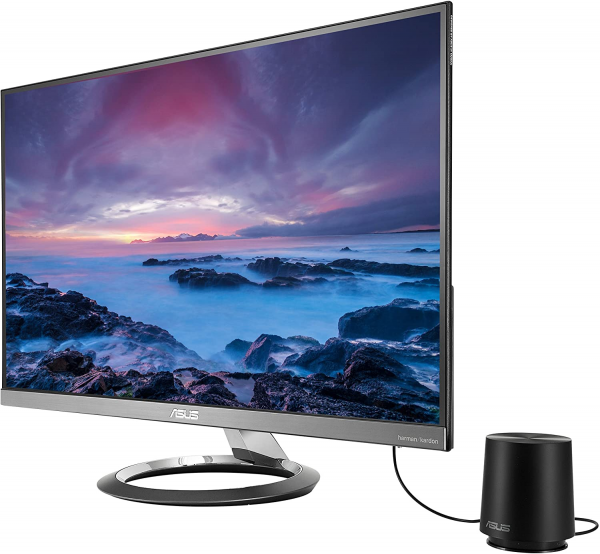Asus
Asus MZ27AQ: a designer monitor that focuses on the audio part
Aprox. 377€
See specificationsThis 27 inch Quad HD monitor proposed to combine the elegance of the Asus Designo range with a slightly more advanced audio system than that of other PC screens.
Positive points
Design.
Finish.
Definition Quad HD.
Viewing angles.
Audio quality (compared to other monitors).
Bad points
No height adjustment or rotation.
No USB ports.
Low contrast.
Our review
Presentation
The Asus Designo MZ27AQ monitor has a 27-inch (≈69 cm) IPS panel displaying a Quad HD definition of 2,560 x 1,440 px. Belonging to the Designo range, this monitor stands out above all by its design, its fine edges and its audio system developed in partnership with Harman / kardon. It therefore has two 6 W speakers and a 5 W wired subwoofer. The Designo MZ27AQ is sold for around € 420.
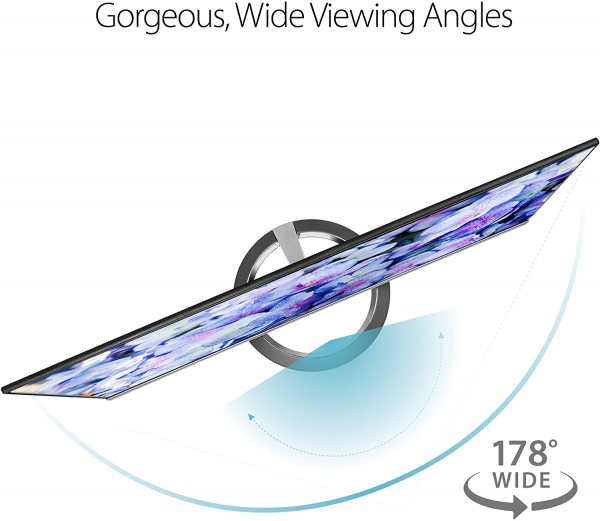
Ergonomics
The Designo MZ27AQ incorporates the codes of the Designo series, including a chrome circular base. It is one of the most beautiful monitors on the market and one of the most sober. It can easily blend into a living room thanks to its sleek design and impeccable finishes. The novelty here is the addition of a small wired subwoofer that slightly breaks the design of the whole.
The foot only offers tilt adjustment. It is impossible to adjust the height - which is far from anecdotal - or the rotation.
Fairly discreet screen edges.
The edges of the screen are relatively thin (7 mm) and the external power supply is compact enough to be forgotten under a desk. It remains more cumbersome than an integrated power supply, but can easily be replaced in the event of a breakdown.
The back of the monitor is very simple and versatile. The upper part is very thin, while the lower part (in lighter gray) contains all the electronics.
Connectivity goes to the basics: two HDMI ports, a DisplayPort input and a headphone output. The micro-jack connector is reserved for the subwoofer. The monitor also has two 6 W speakers set by Harman / kardon as well as a wired subwoofer delivering 5 W (see box).
We measured the consumption of the MZ27AQ at 24 W on our test pattern (white calibrated at 150 cd / m²), ie a relative consumption of 121 W much higher than the average of the monitors tested (100 W / m²). Activating Bluetooth does not cause overconsumption. Small detail that may be important: the power supply is located in an external box.
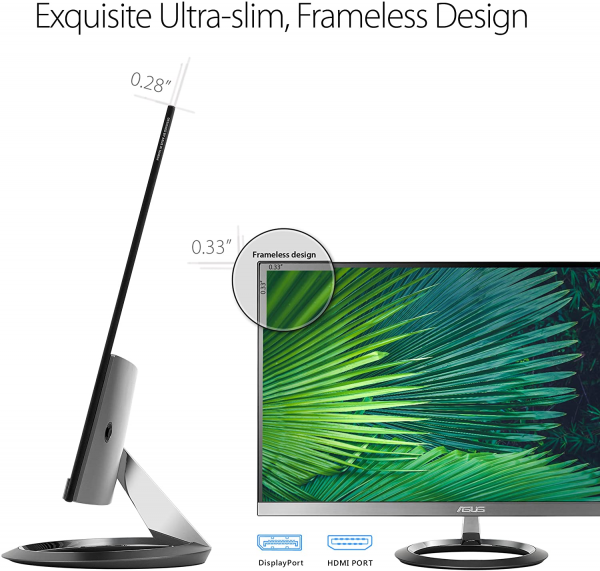
Colors and contrast
Default: average gray temperature: 6,160 K.
Default: gamma curve at 2.4.
Default: Delta E average at 3.3.
Out of the box, the Asus MZ27AQ monitor displays a relatively fair image. The average temperature (6,160 K) is a little far from the 6,500 K reference, but the curve is fairly stable. The gamma curve has a slightly high average (2.4) compared to the reference value 2.2, but benefits from relative stability. Finally, the average delta E measured at 3.3 does not reveal imperfectly faithful colors. In fact, the eye can perceive a difference between the expected color and the color displayed beyond 3.
Manual adjustment: average gray temperature: 6,250 K.
Manual adjustment: gamma curve at 2.3.
Manual adjustment: average delta E at 3.3.
By adjusting the brightness to 36 to obtain a white at 150 cd / m², and the temperature on "warm" for a slightly warmer rendering, the image improves very slightly. The average temperature rises to 6,250 K for a rendering closer to the expected 6,500 K and the gamma drops to 2.3. The colors are identical and still lack a little fidelity, even if it is far from being catastrophic.
Calibrated: average gray temperature: 6.575 K.
Calibrated: gamma curve at 2.2.
Calibrated: average delta E at 2.0.
As usual, going through the calibration step stabilizes the curves. The temperature and gamma curves are now aligned with the reference values, while the average delta E finally becomes less than 3: the colors can therefore be considered as true to the source (with the exception of green or red). The color profile resulting from this calibration is available on this link.
The contrast ratio of 810: 1 is low for an IPS panel. In comparison, the Asus Designo MX27UQ exceeds 1,000: 1 and the best IPS (PLS), like the Philips 276E7, reaches 1,200: 1. In all cases, we are far from the contrasts offered by monitors fitted with a VA panel, such as the Textorm TX32 or the Eizo Fortis FG2421.
The IPS panel offers very open viewing angles with little variation in brightness, whether on the horizontal or vertical axis. The homogeneity of the brightness on the screen is also good. The average difference in white is measured at only 5%. Finally, we did not find any light leakage on our test model.
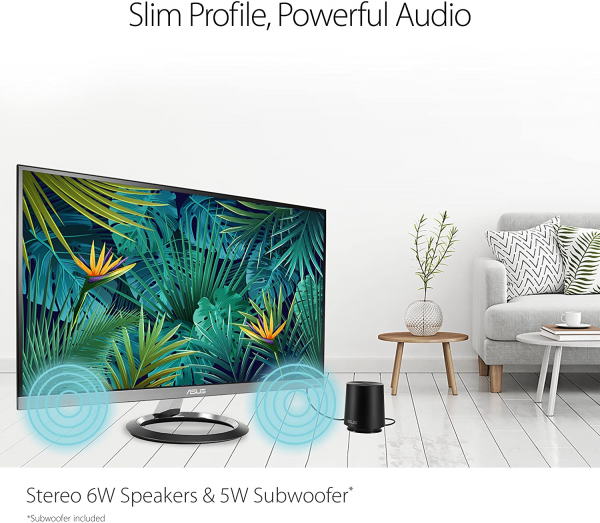
Reactivity
For those who are sensitive to it, be aware that the MZ27AQ does not use Pulse Width Modulation (PWM) to adjust the brightness. It is therefore devoid of flicker. Asus also offers a Blue Light Filter option to limit the emission of blue light on several levels.
The MZ27AQ's IPS panel is in the good average for IPS (average persistence of 10.5 ms). The overdrive is adjustable from 0 to 100 via the Trace Free option. Set to 60, the monitor offers a good response time with a slight controlled ghosting effect. Beyond that, reverse ghosting is far too present and becomes annoying.
The delay in display (input lag) is measured at 10.7 ms, there is less than one frame per second of delay. The delay between sending the image and displaying it on the screen is imperceptible.
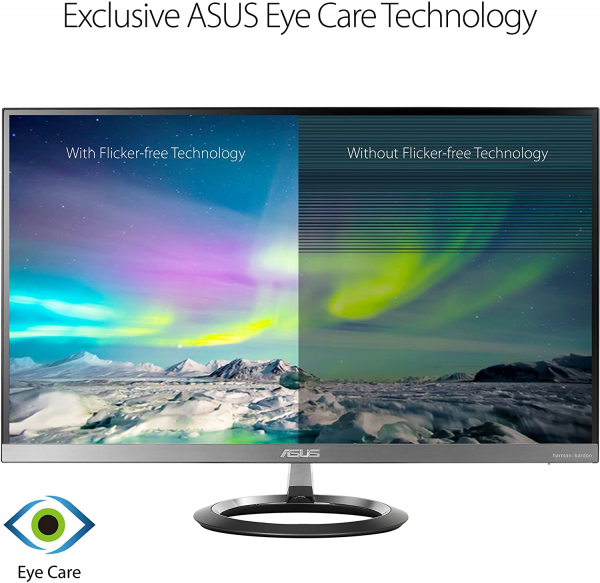
Conclusion
The Asus Designo MZ27AQ monitor is quite average in all respects, but it excels in the audio part. If it doesn't compete with a speaker kit yet, it sounds much better than most monitors. It remains to do with its limited ergonomics and its weak contrast.
Specifications

